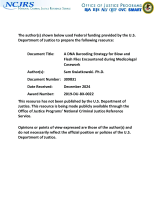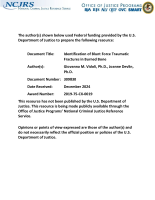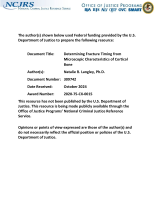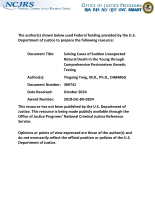Death investigations
Potential Postmortem Microbial Biomarkers of Infant and Younger Children Death Investigation
Investigation into Using Entomology to Improve Methods of Anthropological Post-mortem Interval Estimation
Just Science Podcast: Just Advancements in Death Investigation Practices
An Interdisciplinary Review of the Thanatomicrobiome in Human Decomposition
Overview of Forensic Pathology
Human remains are treated as a separate and unique type of forensic evidence. An autopsy of the remains is conducted to establish the cause and manner of any death that is violent, unusual or untimely. A forensic pathologist completes a post-mortem examination and examine death scene findings. The medical history of an individual may also be reviewed to help determine if the death was natural...
Microscopic Characteristics of Peri- and Postmortem Fracture Surfaces
A DNA Barcoding Strategy for Blow and Flesh Flies Encountered during Medicolegal Casework
Identification of Blunt Force Traumatic Fractures in Burned Bone
Improving and Evaluating Computed Tomography and Magnetic Resonance Imaging in the Investigation of Fatalities Involving Suspected Head Trauma
Determining Fracture Timing from Microscopic Characteristics of Cortical Bone
Solving Cases of Sudden Unexpected Natural Death in the Young through Comprehensive Postmortem Genetic Testing
Postmortem CT Scans Supplement and Replace Full Autopsies
Advancing Justice for the Missing and Unidentified Through Research - 2024 NIJ Research Conference
Forensic science research is developing essential knowledge to fill in the holes in death investigations, creating new ways to identify challenging skeletal remains. These methods inform cause of death, time of death, and familial relationships to guide investigations, identify suspects, support prosecutions, and bring justice to families.
See the YouTube Terms of Service and Google Privacy Policy
Cardiac Genetic Test Yields and Genotype-phenotype Correlations from Large Cohort Investigated by Medical Examiner's Office
A Focused Deterrence Program for Juveniles with Firearm Offenses: a Randomized Controlled Trial and Process Evaluation
Investigations Toward Development of a Technique for Rapid Identification of Forensically Relevant Necrophagous Beetle Species for Postmortem Interval Determination
MDI Myth: Rapid Toxicology Screening Tools Can Replace Traditional Toxicology Testing – No Need to Confirm
MDI Myth: Talking with Decedent's Families is Simple and Routine








